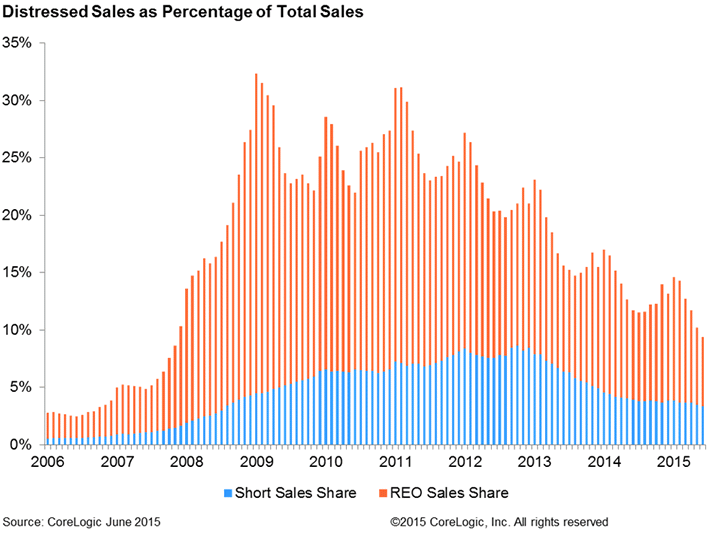While sales of lender owned real estate (REO) and short sales continue to account for around one-fifth of all home sales in at least five states the share of distressed home sales is steadily returning to normal levels on a national basis. CoreLogic said today that REO sales accounted for 6 percent of all residential sales in June, the lowest share since September 2007 when it was 5.2 percent. Short sales made up 3.4 percent of the total.
The combined distressed sales share, 9.4 percent, is down 2.4 percentage points from June 2014 and 0.9 point from May, bringing the share into single digit territory. CoreLogic says these sales typically dip in June due to seasonal factors but this month's share was the lowest for June since it hit 4.9 percent in 2007.

Florida had the largest share of distressed sales of any state at 21 percent in June 2015, followed by Michigan (20.7 percent), Maryland (20.5 percent), Connecticut (19.3 percent) and Illinois (19.1 percent). Nevada had a 6.8 percentage point drop in its distressed sales share from a year earlier, the largest decline of any state. California has improved the most from a state-level peak, falling 58.3 percentages points since the January 2009 distressed sales share of 67.4 percent.
Among the 25 largest Core Based Statistical Areas based on loan count the highest share of distressed sales were in Orlando at 24.2 percent, followed by Miami (22.8 percent), Tampa-St. Petersburg-Clearwater. (22.5 percent), Chicago (22 percent) and Baltimore (20.6 percent).
At the peak in January 2009, 32.3 percent of all home sales nationally were distressed properties. REO sales alone accounted for 27.9 percent. The declining share of the latter are a driver of improving home prices as lender-owned properties typically sell at a greater discount from market value than do short sales.
The pre-crisis share of distressed sales was traditionally about 2 percent. CoreLogic says while There will always be some level of distress in the housing market, if the current year-over-year decrease in the distressed sales share continues, it would reach that "normal" 2-percent mark in mid-2018. Only North Dakota and the District of Columbia are even close to their pre-crisis numbers.







